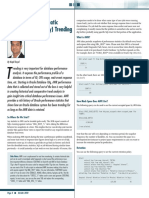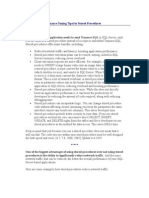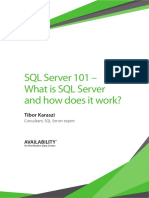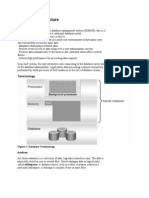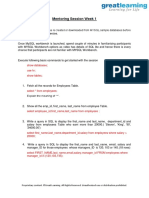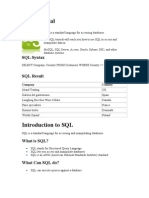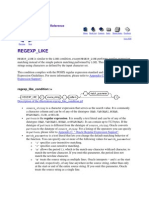0 ratings0% found this document useful (0 votes)
309 views25 pagesSQL Queries
sql queries
Uploaded by
ashokkumar gCopyright
© © All Rights Reserved
We take content rights seriously. If you suspect this is your content, claim it here.
Available Formats
Download as PDF or read online on Scribd
0 ratings0% found this document useful (0 votes)
309 views25 pagesSQL Queries
sql queries
Uploaded by
ashokkumar gCopyright
© © All Rights Reserved
We take content rights seriously. If you suspect this is your content, claim it here.
Available Formats
Download as PDF or read online on Scribd
You are on page 1/ 25
udayarumilliccom
SQL DBA INTERVIEW QUESTIONS WITH ANSWERS - 1
SQL DBA Interview Questions with Answers - 1
a
ia
Microsoft
SQL DBA INTERVIEW QUESTIONS - PART 1
SQL DBA Interview Questions with Answers
Q. What are the common issues a SQL DBA should deal with as a part of DBA daily job?
Ans:
= Backup Failure
= Restore Failure
= Log Full Issues
= Blocking Alerts
= Deadlocksilerts
= TEMPDF sues
= DiskFuC
= SQL Connectivity Issues
= Access issues
* Installation and Upgrade Failures
= SQL Agent Job failures
= Performance Issues
= Resource (Memory/IO/CPU etc.) Utilization Alerts
= High-Availability and Disaster Recovery related issues
Q. “model” system DB is down and we are trying to create a new database. Is it possible to create a new
database when model DB is down?
Ans:
We can't create a new database when model database is down. SQL Server restart will be unsuccessful when
model database is down as TEMPDB creation failed. TEMPDB is created based on model DB configurations, since
model DB is down TEMPDB will not be created.
Q. Which operation is faster COMMIT or ROLLBACK? Why?
Ans:
It’s obviously COMMIT is faster than ROLLBACK. Let me explain with an example: Let’s say we opened a
transaction and updated 8000 records:
Commit: It’s completed quickly as the operation is already completed and it just marks those dirty pages as
‘committed and when checkpoint happens all those dirty pages will be written to disk.
Rollback: The operation is already updated 8000 records if we need to rollback then again all these updates
has to be rolled back which means there are another 8000 log records will be written to LDF which will take
time when compared to commit.
Q. What are the different ways available to insert data from a file into SQL Server database table?
Ans:
These are the different ways:
= BCP
= BULKINSERT
= OPENROWSET
= OPENDATASOURCE
= OPENQUERY
‘= LINKED SERVER
= IMPORT/EXPORT WIZARD
= SSIs
Q. What is the scope of different temp objects?
48.
Ans:
REATE TABLE #TempTable”
Local temporary tables are visible only in the current session, and can be shared between nested stored
procedure calls
Table Variable: “DECLARE TABLE @TempTable”
The scope of a local variable fs the batch, stored procedure, or statement block in which it is declared. They
‘can be passed as parameters between procedures. They are not subject to transactions and will retain all rows
following a rollback.
Derived Table: “SELECT * FROM (SELECT * FROM Customers) AS TempTable”
Is visible to the current query only
Global Temp Table: “CREATE TABLE ##TempTable”
This differs from a #temp table in that it is visible to all processes. When the creating process ends, the table
is removed (but will wait until any current activity from other processes is done).
CTE: Common Table Expression
Example CTE:
sWITH YourBigCTE AS
big query here
SELECT * FROM YourTable1 WHERE ID IN (SELECT ID FROM YourBigCTE)
UNION
SELECT * FROM YourTable2 WHERE ID IN (SELECT ID FROM YourBigCTE)
Scope is next immediate select command. Can be used multiple times within the same CTE command, even
recursively, and will last for the duration of the CTE command.
Q. What is the maximum limit of SQL Server instances for a standalone computer?
Ans:
50 instances on a stand-alone server for all SQL Server editions. SQL Server supports 25 instances on a failover
cluster.
Q. What is the cluster node limitation?
Ans:
The number of allowable nodes in the SQL Server cluster depends on your SQL Server version and your Windows
Server version. For SQL Server 2008 Standard edition, you can only have two cluster nodes. If you have SQL
Server Enterprise, the limit depends on your Windows Server version, 8 cluster nodes for 2003 and 16 nodes for
2008,
Q. Can we install SQL Server using a configure file?
Ans:
x
specified in the “Ready to Install” page in the configuration file path section. Cancel the setup without
actually completing the installation, to generate the INI file.
We can prepare a configuration file. While installing SQL Server the path to the configuration file is
File Location and Name:
‘%programfiles%s\Microsoft SQL Server\110\Setup Bootstrap\Log\\ConfigurationFile. ini.
Q. How to install a SQL Server using configuration file?
Ans:
From Command prompt locate the setup.exe file location and can install using config file.
Setup.exe /ConfigurationFile=MyConfigurationFile.INI
Instead of specifying passwords inside the config file specify them explicitly as below.
Setup.exe /SQLSVCPASSWORD="***####+#54"" /AGTSVCPASSWORD="**#54#58#5447"
IASSVCPASSWORD=""***##*##484"" /ISSVCPASSWORD="***#**#**#"4" /RSSVCPASSWORD=
‘JConfigurationFile=MyConfigurationFile. INI
Q. What are the top performance counters to be monitor in Performance Monitor?
Ans:
Processor\%Processor Time: Monitoring CPU consumption allows you to check for a bottleneck on the server
{indicated by high sustained usage).
High percentage of Signal Wait: Signal wait is the time a worker spends waiting for CPU time after it has
finished waiting on something else (such as a lock, a latch or some other wait). Time spent waiting on the CPU
is indicative of a CPU bottleneck. Signal wait can be found by executing DBCC SQLPERF (waitstats) on SQL
Server 2000 or by querying sys.dm_os_wait_stats on SQL Server 2005.
Physical Disk\Avg. Disk Queue Length: Check for disk bottlenecks: if the value exceeds 2 then it is likely that.
a disk bottleneck exists.
MSSQLSinstance: Buffer Manager\Page Life Expectancy: Page Life Expectancy is the number of seconds a
page stays in the buffer cache. A low number indicates that pages are being evicted without spending much
time in the~ Se, which reduces the effectiveness of the cache.
MSSQLSinst.. et Plan Cache\Cache Hit Ratio: A low Plan Cache hit ratio means that plans are not being
reused,
‘MSSQLSInstance:General Statistics\Processes Blocked: Long blocks indicate contention for resources.
Q. Task manager is not showing the correct memory usage by SQL Server. How to identify the exact
memory usage from SQL Server?
Ans:
‘To know the exact memory usage relay on column “physical_memory_in_use_kb” from DMV
“sys.dm_os_process_memory”.
Using performance counters also we can find the usage.
Performance object: Process
Counter: Private Bytes
Instance: sqlservr
Performance object: Process
Counter: Working Set
Instance: sqlservr
The Private Bytes counter measures the memory that is currently committed. The Working Set counter
measures the physical memory that is currently occupied by the process.
For 64-bit sql servers we can also check the current memory usage using the below performance counter.
Performance object: SQL Server:Memory Manager
Counter: Total Server Memory (KB)
Q. What is the option “Lock Pages in Memory”?
Ans:
Lock Pages in Memory is a setting that can be set on 64-bit operating systems that essentially tell Windows not
to swap out SQL Server memory to disk. By default, this setting is turned off on 64-bit systems, but depends on
various conditions this option needs to be turned on.
48
We must b: careful in dealing with this option. One can enable this after a detailed analysis of current
environme
Following issues may rise when “Lock Pages in Memory” is not turned on:
= SQL Server performance suddenly decreases.
= Application that connects to SQL Server may encounter timeouts.
= The hardware running SQL Server may not respond for a short time periods.
Q. How do you know how much memory has been allocated to sql server using AWE?
Ans:
We can use DBCC MEMORYSTSTUS command to know the memory allocation information. But it’s trick to
understand the results.
We can use a DMV called “sys.DM_OS_Memory_Clerks”. Sample query to calculate total AWE memory allocated
is “SELECT SUM(awe_allocated_kb) FROM sys.dm_os_memory_clerks”
From 2008 onwards we can get all memory related information using DMV “sys.dm_os_process_memory”.
Q. How to apply service pack on Active / Passive cluster on 2008 and 2012?
Ans:
1. Freeze the service groups on Node A (active node).
2. Confirm all SQL services are stopped on Node B.
3. Upgrade the SQL Server 2008 instance on Node B.
4, Reboot node B.
5. Unfreeze the service group on node A.
6. Fail over the service group to Node B.
7. After the service group comes online, freeze the service group on Node B.
8. Confirm all SQL services are stopped on Node A.
9. Upgrade the SQL Server 2008 instance on Node A.
10. Reboot Node A.
11. Unfreeze the service group on node B.
12. Fail back the service group to Node A.
Q. How to apply a SP on SQL Server 2005 Active / Passive cluster?
Ans:
1. Login to the Console on the target node
a. RDP to the console is ok, but a standard RDP connection is not recommended,
2. Copy the Service Pack to a local drive on the target node
3. Move all instances to the target node
a. You can only install on the Active Node.
4, Move the Cluster Resource to the target node
5. Move the MSDTC Resource to the target node
6. Verify all users are logged out from all other nodes (RDP and Console sessions)
7. Start the Service Pack install
a. Use a domain account with admin rights to all servers.
b. Ignore locked files
8. Reboot current server
a. You should not need to perform the install on any other nodes, nor reboot them. The service pack will
update the passive nodes first.
Q. You find SP is not applied on all the nodes across the cluster. How to apply SP only on required nodes?
Ans:
If you find that the product level is not consistent across all the nodes, you will need to fool the 2005 patch
installer into only patching the nodes that need updating. To do so, you will have to perform the following
steps:
1, Fail Instance, Cluster, and MSDTC groups to an unpatched node
2. Remove any successfully patched nodes from failover candidates of the SQL Server Service of the instance
group (do this using Cluster Admin tool)
3. Run the patch
4. After the patch installs successfully, add the Nodes removed in Step 2 back to the SQL Server Service of the
Instance group
Why do you need to do this? Well when the patch installer determines that not all nodes in the cluster are at
the same patch level, a passive node operation will fail and will prevent you from moving forward with any
further patching.
Q. How to change the sql server service account in a cluster environment?
Ans: AB.
Method 1: uilover required)
1. Freeze the service group on active node from cluster administrator and then restart the service.
Method2:
1, Offline the SQL resources
2. Update the service account at SSCM and restart the service as needed
3. Add the SQL resources back to online
Note: Don't forget to update service account at the remaining nodes on the cluster.
Method
1, Node 2 (inactive node) change the SQL startup account in SQL Studio or SCM
2. Fail over the SQL service group from node 1 to node 2.
3. Node 1 (now the inactive node) change the SQL startup account in SQL Studio or SCM
Q. How to apply service pack on Active / Active cluster Nodes?
Ans:
1. Make a note of all node names (and/or IP addresses), SQL Server virtual names along with preferred nodes.
If there are more than three nodes you may need to also take note of possible owners for each SQL resource
group. For my example assume that | have a cluster with nodet and node2, SQL1 normally lives on nodet and
SQL2 normally lives on node2.
2. To start with a clean slate and ensure any previous updates are completed both nodes should be restarted if
possible. Choose the physical node that you you want to patch second and restart that node (in my example
node2)..
3. Restart the node you want to patch first (node1). This will mean that both active SQL instances are now
running on node2. Some restarts will be essential, but you could avoid the first two restarts if you need to keep
downtime to a minimum and just fail SQL1 over to node2. The main point here is to always patch a passive
node.
4, In cluster administrator remove nodet from the possible owners lists of SQL1 and SQL2. This means that
neither SQL instance can fail over to nodet while itis being patched.
5. Run the service pack executable on nodet.
6. Restart nodet.
7. Add nodet back into the possible owners lists of SQL1 and SQL2 and fail both instances over to node1.
8. Repeat steps 4- 6 on node2.
48
9. Add noe’ ‘cinto the possible owners lists of SQL1 and $QI2 and fail both instances over to node2. Check
that the bu. vel is correct and review the SQL Server error logs.
10. Fail SQL! over to nodet. Check build levels and SQL Server error logs
Q. What are the main events and columns helpful in troubleshooting performance issues using profiler?
Ans:
Events:
Event Group: Performance
Event: ShowPlan_ALL (BinaryData column must be selected)
Event: ShowPlan_XML
Event Group: T-SQL
Event: SQL:BatchStarted
Event: SQL:BatchCompleted
Event Group: Stored Procedures
Event: RPC:Completed
Event Group: Locks
Event: Lock: Deadlock Graph
Event: Lock: Lock Deadlock Chain (Series of events that leaads to a deadlock)
Event Group: Sessions
Event: Existing Connection
Event Group: Security Audit
Event: Audit Login
Event: Audit Log Out
Columns:
Below are the most common columns that help us in understanding the trace file to troubleshoot the problems.
TextData
ApplicationName
NTUserName
48.
LoginName
cpu
Reads
Writes
Duration
sPID
StartTime
EndTime
Database Name
Error
HostName
LinkedServerName
NTDomainName
ServerName
SQLHandle
All these columns need not be available for all of the events, but depends on the event select we have to.
choose the appropriate columns.
Filters:
ApplicationName
DatabaseName
DBUserName
Error
HostName
NTUserName
NTDomainName
Q. What are the agents in replication?
Ans: As.
Snapshot A. Copy SchemasData to snapshot folder on distributer. Used in all types of replication.
Log reader Agent: Sends transactions from Publisher to Distributor. Used in transactional replication
Distribution Agent: Applies Snapshots / Transactions to all subscribers’ runs at distributer in PUSH and Runs at
Subscriber in PULL. Used in transactional and transactional with updatable subscriptions.
Queue reader Agent: Runs at distributer send back transactions from subscriber to publisher. Used in
‘Transactional With updatable subscriptions.
‘Merge Agent: Applies initial snapshot to subscribers, from the next time synchronize by resolving
the conflicts.
Q. Can we configure log shipping in replicated database?
‘Ans: Yes
Replication does not continue after a log shipping failover. If a failover occurs, replication agents do not
connect to the secondary, so transactions are not replicated to Subscribers. If a failback to the primary occurs,
replication resumes. All transactions that log shipping copies from the secondary back to the primary are
replicated to Subscribers.
For transactional replication, the behavior of log shipping depends on the sync with backup option. This option
‘can be set on the publication database and distribution database; in log shipping for the Publisher, only the
setting on the publication database is relevant.
Setting this option on the publication database ensures that transactions are not delivered to the distribution
database until they are backed up at the publication database. The last publication database backup can then
be restored at the secondary server without any possibility of the distribution database having transactions
that the restored publication database does not have. This option guarantees that if the Publisher fails over to
a secondary server, consistency is maintained between the Publisher, Distributor, and Subscribers. Latency and
throughput are affected because transactions cannot be delivered to the distribution database until they have
been backed up at the Publisher.
Q. What are the best RAID levels to use with SQL Server?
Ans:
Before choosing the RAID (Redundant Array of Independent Disks) we should have a look into usage of SQL
Server files.
‘As a basic thumb rule “Data Files” need random access, “Log files” need sequential access and “TempDB” must
be on a fastest drive and must be separated from data and log files.
We have to consider the below factors while choosing the RAID level:
Reliability
Storage Efficiency
Random Ri
Random Write
Sequential Write
Sequential Write
Cost.
‘As an Admin we have to consider all of these parameters in choosing the proper RAID level. Obviously the
choice is always between RAID-5 and RAID-10
Q. How to monitor latency in replication?
Ans:
There are three methods.
1. Replication monitor
2. Replication commands
3. Tracer Tokens
1. Replication Monitor: In replication monitor from the list of all subscriptions just double click on the desired
subscription. There we find three tabs.
= Publisher to Distributor History
* Distributor to Subscriber History
= Undistributed commands
2, Replication Commands:
Publisher.SP_ReplTran: Checks the pending transactions at p
Distributor.MSReplCommands and MSRepITransactions: Gives the transactions and commands details. Actual
‘T_SQL data is in binary format. From the entry time we can estimate the latency.
Distributor.SP_BrowseRepiCmds: It shows the eaxct_seqno along with the corresponding T-SQL command
sp_repimonitorsubscriptionpendingcmds: It shows the total number of pending commands to be applied at
subscriber along with the estimated time.
3, Tracer Token:
Available from Replication Monitor or via TSQL statements, Tracer Tokens are special timestamp transactions
written to the Publisher's Transaction Log and picked up by the Log Reader. They are then read by the
Distribution Agent and written to the Subscriber. Timestamps for each step are recorded in tracking tables in
the Distribution Database and can be displayed in Replication Monitor of via TSQL statements.
When Log Reader picks up Token it records time in MStracer_tokens table in the Distribution database. The
Distribution ~ nt then picks up the Token and records Subscriber(s) write time in the MStracer_history tables
also in the tion database.
Below is the T-SQL code to use Tracer tokens to troubleshoot the latency issues,
-A SQL Agent JOB to insert a new Tracer Token in the publication database.
USE [AdventureWorks]
Go
EXEC sys.sp_posttracertoken @publication =
Go
Token Tracking Tables
USE Distribution
Go
-publisher_commit
SELECT Top 20 * FROM MStracer_tokens Order by tracer_id desc
-subscriber_commit
SELECT Top 20 * FROM MStracer_history Order by parent_tracer_id desc
Q. Can we perform a tail log backup if .mdf file is corrupted?
Ans:
Yes we can perform a tail log as long as the ldf if not corrupted and no bulk logged changes.
A typical tail log backup is having two options, 1. WITH NORECOVERY 2. Continue After Error.
1. WITH NORECOVERY: To make sure no transactions happens after the tal log backup
2. CONTINUE AFTER ERROR: Just to make sure log backup happens even though some meta data pages
corrupted.
Q. Let’s say we have a situation. We are restoring a database from a full backup. The restore operation ran
for 2 hours and failed with an error 9002 (Insufficient logspace). And the database went to suspect mode.
How do you troubleshoot this issue?
Ans:
In that case we can actually add a new log file on other drive and rerun the restore operation using the system
stored procedyre “sp_add_log_file_recover_suspect_db”. Parameters are the same as while creating a new
log file.
Q. Let’s say we have a situation, We are restoring a database from a full backup. The restores operation
runs for 2 hours and failed with an error 1105 (Insufficient space on the file group). And the database
went to suspect mode. How do you troubleshoot this issue?
Ans:
In that case we can actually add a new data file on another drive and rerun the restore operation using the
system stored procedure “sp_add_data_file_recover_suspect_db”. Parameters are the same as while
creating a new data file.
Q. Can you describe factors that causes the logfile grow?
Ans:
= CHECKPOINT has not occurred since last log truncation
= No log backup happens since last full backup when database is in full recovery
= An active BACKUP or RESTORE operation is running from long back
= Long running active transactions
= Database mirroring is paused or mode is in high performance
= In replication publisher transactions are not yet delivered to distributer
= Huge number of database snapshots is being created
Q. How do you troubleshoot a Full transaction log issue?
Ans:
Columns log_reuse_wait and log_reuse_wait_desc of the sys.databases catalog view describes what is the
actual problem that causes log full / delay truncation.
= Backing up the log.
‘= Freeing disk space so that the log can automatically grow.
= Moving the log file to a disk drive with sufficient space.
= Increasing the size of a log file.
= Adding a log file on a different disk.
= Completing or killing a long-running transaction,
http://msdn.microsoft.com/e
5 library /ms345414.aspx
Q. Does “Truncate” works in transactional replication?
Ans:
No! As per MSDN blogs information we can’t use TRUNCATE on published database against the published article
instead we have to use “DELETE” without where clause.
Q. Consider a situation where publisher database log file has been increasing and there there is just few
‘MB available on disk, As an experienced professional how do you react to this situation? Remember no disk
space available and also we can’t create a new log file on other drive
Ans: 48
Essentially. e to identify the bottleneck which is filling the log file.
‘As a quick resolution check all possible solutions as below:
= Resolve if there are any errors in log reader agent / distribution agent
' Fix if there are any connectivity issues either between publisher - distributor or distributor
= Fix if there are any issues with 1/0 at any level
= Check if there is any huge number of transactions pending from publisher
= Check if there are any large number of VLF’s (USE DBCC Loginfo)which slows the logreader agent work.
= Check all database statistics are up-to-date at distributer. Usually we do siwtch off this “Auto Update Stats”
by default.
= To find and resolve these issues we can use “Replication Monitor”, “DBCC Commands”, “SQL Profiler”,
“System Tables / SP / Function”.
If incase we can’t resolve just by providing a simple solution we have to shrink the transaction log file. Below
are two methods.
To shrink the transaction log fil
1, Backup the log — So transactions in vif’s are marked as inactive
2. Shrink the logfile using DBCC SHRINKFILE - Inactive VLF's would be removed
3. If you find no difference in size repeat the above steps 1 and 2
To truncate the transaction log file:
In any case we are not able to provide the solution against the increasing logfile the final solution is disable the
replication, truncate the log and reinitialize the subscribers.
1. Disable replication jobs
2. Execute SP_Rep\Done procedure. It disable the replication and mark as “Replicate done” for all pending
transactions at publisher.
3. Backup the transaction log “WITH TRUNCATE” option.
4, Shrink the log file using “DBCC SHRINKFILE”
5. Flues the article cache using “sp_replflush”.
6. Go to distributor database and truncate the table MSRepl_Commands
7. Connect to replication monitor and reinitialize all subscriptions by generating a new snapshot.
8. Enable all replication related jobs.
Q. Can we add an article to the existing publication without generating a snapshot with all articles?
Ans:
48
Yes! We ce at. Follow the below steps to publish a new article to the existing publication.
‘There are two parameters that we need to change to “False”. 1. Immediate Sync and 2. Allow_Ananymous.
Both the fields were set to ON by default. If the Immediate_sync is enabled every time you add anew article it
will cause the entire snapshot to be applied and not the one for the particular article alone.
Steps:
1, Change the values to “True” for publication properties “Immediate_Sync” and “Allow_Anonymous” using
SP_CHANGEPUBLICATION
2, Add a new article to the publication using SP_AddArticle. While executing this procedure along with the
required parameters also specify the parameter “@force_invalidate_snapshot=1".
3. Add the subscriptions to the publication for the single table/article uisng “SP_ADDSUBSCRIPTION”. While
executing this proc specify the parameter “@Reserved = Internal”. Generate a new snapshot which only
includes newly added article.
Q. How MAXDOP impacts SQL 5
Ans:
The Microsoft SQL Server max degree of parallelism (MAXDOP) configuration option controls the number of
processors that are used for the execution of a query in a parallel plan. This option determines the computing
and threads resources that are used for the query plan operators that perform the work in parallel.
For servers that use more than eight processors, use the following configuration:
‘MAXDOP=8,
For servers that use eight or fewer processors, use the following configuration:
MAXDOP=0 to N
Q. How distributed transactions works in SQL Server?
Ans:
Distributed transactions are the transactions that worked across the databases, instances in the given session.
Snapshot isolation level does not support distributed transactions.
We can explicitly start a distributed transaction using “BEGIN DISTRIBUTED TRANSACTION ”
For example, if BEGIN DISTRIBUTED TRANSACTION is issued on ServerA, the session calls a stored procedure on
ServerB and another stored procedure on ServerC. The stored procedure on ServerC executes a distributed
query against ServerD, and then all four computers are involved in the distributed transaction. The instance of
the Database Engine on ServerA is the originating controlling instance for the transaction.
When a distributed query is executed in a local transaction, the transaction is automatically promoted to a
distributed * action if the target OLE DB data source supports (TransactionLocal. If the target OLE DB data
source doe sport ITransactionLocal, only read-only operations are allowed in the distributed query.
In order to work with these transactions, make sure below settings are done.
1, MSDTC must be running on all supported instances
2, Choose the option “No authentigation required” from MSDTC properties
3. Turn on random options at linked server properties like “RPC”, “RPC Out”, “Data Access” etc.
Q. Can you give some examples for One to One, One to Many and Many to Many relationships?
Ans:
One to One: Citizen - UID
A citizen can have only one UID - A UID can represent only one citizen
One to Many: Customer - Products
‘A-customer can sale number of products - A product can be brought by only one customer
‘Many to Many: Book - Author
‘A book can be written by more than one author - An author can write more than one book
Q. What are the phases of sql server database restore process?
Ans:
1. Copy Data: Copies all data,log and index pages from backup file to database mdf, ndf and Idf files
2. REDO: Rollfoward all committed transactions to database and if it finds any uncommitted transactions it
goes to the final phase UNDO.
3. UNDO; Rollback any uncommitted transactions and make database available to users.
Q. I wanted to know what are the maximum worker threads setting and active worker thread count on sql
server. Can you tell me how to capture this info? What's the default value for max thread count?
Ans:
We can check the current settings and thread allocation using the below queries.
-Thread setting
select max_workers_count from sys.dm_os_sys_info
-Active threads
select cou \m sys.dm_os_threads
Default value is 255.
Increasing the number of worker threads may actually decrease the performance because too many threads
causes context switching which could take so much of the resources that the OS starts to degrade in overall
performance.
Q. Can you explain sql server transaction log architecture?
Ans:
We need to spend some time on this as every SQL DBA must aware of this concept.
http://www. sqlservercentral.com/articles/Stairway-Series/73775/
Q. See I have an environment, Sunday night full backup, everyday night diff backup and every 45 min a
transactional backup. Disaster happened at 2:30 PM on Saturday. You suddenly found that the last Sunday
backup has been corrupted. What's your recovery plan?
Ans:
When you find that the last full backup is corrupted or otherwise unrestorable, making all differentials after
that point useless. You then need to go back a further week to the previous full backup (taken 13 days ago),
and restore that, plus the differential from 8 days ago, and the subsequent 8 days of transaction logs (assuming
one of those ended up corrupted
If you're taking daily full backups, a corrupted full backup only introduce an additional 24 hours of logs to
restore.
Alternatively, a log shipped copy of the database could save your bacon (you have a warm standby, and you
know the log backups are definitely good).
Q. Full backup size is 300 GB, usually my diff backup size varies between 300 MB and 5 GB, one day
unfortunately diff backup size was increased to 250 GB? What might be the reason any idea?
Ans:
‘Are you the kind of DBA who rebuilds all indexes nightly? Your differential backups can easily be nearly as large
as your full backup. That means you're taking up nearly twice the space just to store the backups, and even
worse, you're talking about twice the time to restore the database.
To avoid these issues with diff backups , ideally schedule the index maintenance to happen right before the full
backup.
Q. What is . TUF file? What is the significance of the same? Any implications if the file is deleted?
Ans:
TUF file is the Transaction Undo File, which is created when performing log shipping to a server in Standby
mode.
When the database is in Standby mode the database recovery is done when the log is restored; and this mode
also creates a file on destination server with .TUF extension which is the transaction undo file.
This file contains information on all the modifications performed at the time backup is taken.
The file plays a important role in Standby mode... the reason being very obvious while restoring the log backup
all uncommited transactions are recorded to the undo file with only commited transactions written to disk
which enables the users to read the database. So when we restore next transaction log backup; SQL server will
fetch all the uncommited transactions from undo file and check with the new transaction log backup whether
commited or not.
If found to be commited the transactions will be written to disk else it will be stored in undo file until it gets
commited or rolledback.
If .tuf file is got deleted there is no way to repair logshipping except reconfiguring it from scratch.
1000 Plus Professional SQL Server Interview Questions and Answers
Related:
stent SQL OBA | Chstered index on L Server
SCL Server Health | tnterview Question | Uniqueldentiier || Stellar OB Tethit wing Fitered
Check WT Report and Arawers Cohen Renes Covering Weds
Create a Virtual
machine on your
| taptap tor tree
Pest in ner QA, $4 Server DBA | Taspd DBA, DRA QUESTIONS AND ANSWERS, POERINCED OBA, EERIENCED DRA NTERVEW QUESTIONS WIT ANSWERS,
INTERVIEW QUESTIONS FOR EXPERIENCED QUESTIONS, sl serve, SOL SERVER DATABASE ADMIN NTERVIEW QUESTIONS, sl SERVER OSA | 48 Comores
48
gribe
© Join the discussion
mor ord
48 COMMENTS
© Kotesh © 7yanae
Udaya..Very mich informative you're awesome.
o= Sy Reply
© day arumilh (@wday) © 7.08
Rept Kets
“Thanks Kotesh
bom Realy
© ITISHREE PANDA © 7ye03 0
‘This post 0 helpful. Thanks a Lot ®
fom Reply
© day arumilli (@uday) © 7yeasote
Reply to ITISHREE PANDA
Thanks Panda.
HOS Reply
© kiran © ryear a6
nice and superb information.thanks for ur valuable information
$O— Reply
© luday arumilli @uday) © 7yeaeage
Repy 0 tian
Thanks much Kiran.
FO Renty
© Shiva © Tyee
‘You Rock Uday.! One ofthe best SQL DBA Q&A in Internet.
Om Reply
© day arumilll (@uday) © Tyan
2 Reply to shiva
Thank you so much Shiva
Om Realy
Gopi © éyear ae
Thank you
om Reply
©
satlsh © éyear ae
very helpful
Reply
©
uday arumilli (Guday) © éyes
2 Reply to satsh
‘Thanks Satish
$o= \ Renly
© kumar © 6 yeas ase
Very useful information and iti really helpfull to DBA's. Great job Uday.
om Reply
© ‘day arumilll (@uday) © éyeanage
& reply to Luror
“Thank Yu So much Kura
o— \ Renly
© ravi kumar © 696
{s there no tu ile come into the picture when we configure (og shipping in restoring mode??
om Reply
© Sandeep © éyeaase
Uday Great job man I! Your blog isso awesome and one of the top blogs on SQL server by an
Indian, Proud of you
OY Reply
© day arumiltl(@uday) © éyeasene
Reply to Sandeep
sandeep,
‘Thank you so much for your comments and visiting our blog
Happy Reading
itp: udayarumili.comd
$o= S Reply
© SUDHEER KUMAR © 6yews
It was very useful info posted very thankful to u..Blog is containng worthy subject.in eed to
QI. DBAs. thanks Uday
OS Reply
© Luday arumilli (@uday) © 6yees
2 Reply to SUDHEER KUMAR
Thank You So much Sudheer!
Heppy Reading
ldo: /Mudayacumili.comd
$o= \ Reply
© KASHI © syensase
Very Nice Thanks
om Renly
© Luday arumilli (@uday) © evens
48 2 Reply to KASH
‘Thanks Kash
Hoppy Reading
itp: udayarumilt.comd
$o= YS Revly
©
Ram TS © eyewsae
Very useful information andi is really helpful to OBA’,
could please explain about the bad parameters sniffing... ooking for your valuable reply
fo Renly
© day arumill (@uday) © syanane
© hesy to ta
‘Thanks Rar When a query submited to sal server, it designs an execution plan to find a best
and shortest path to get the data, It consider lot of things while designing execution plan that
Includes “Indexes”, “Statistics” etc. Once the plan designed it keeps the plan in cache. When
‘ext time the same procedure is called sal server checks the cache and if there is already plan
avaiable same will be considered. Lets considera stored procedure with parameters and these
parameters used in queries inside the stored procedure. When the fist time stored procedure
‘executed execution plan i. Read more »
om S Realy
Shanthi © ¢yearase
Wonderful information Uday. The way you explained every single question was very good and
helped in better understanding.
fom Reply
© ‘day arumlll (@uday? © eyeasene
2 Repyto Shanthi
© Shanthi,
‘Thanks for visiting our blog.
Regards
day Arum
$o= YS Rely
Sulakshana © éyear a6
‘Thanks alot..dear
Helpful info...
om \ Rely
© ‘uday arumilli (@uday) © éyeanase
2 Reply to Sulalshano
Sulakshana,
‘Thank you so much for visiting our blog.
Happy Reading
‘The SQL Team
tte udayarumill.comd
$o= \ Rely
Rakesh Reddy © syeesago
What kind of stuff you are writing, Its really awesome...Unknowingly you built my confidence
thrible..You rock (Y)
fom Rey
“
© day arumill (@uday) © symone
1 hey to Shen Rey
‘Thank you so much Rakesh, Weare gold to here you ®
Happy Reading
‘The Team SQ
tte /Mudayacumili.come
©
€& ©
48
bom S kevy
teja © Syeum ose
plz post related to perfomance and maintenance related interview questions
fo Reply
© ‘day arumlll (@uday) © syeasaee
2 Repyto te)e
Hi Tes,
Wie have been collecting and preparing questions and answers for SQL Server inépeth
performance tuning
‘Meantime please have a look at here: tg://udayarumill.com/ss)-server-performance-tuning:
‘Also you can find index, tempdb , CPU, Memory related interview question,
Happy Reading
‘The Team SQ
tps wm udayarumilcom
fom S Realy
Tekclasses © syeas ae
Very good collection of question and answers thank you for sharing this article with us. Know more
about SQL Training
oS Reply
anusha © 5 yeusog
thanks for ths sharing the lot of interview tips
fo Reply
dinesh vishe © syewsase
Excellent question ang answer..
fom Y Revly
© day arumilli (@uday) © syeaago
2 Repyto sine she
Dinesh Dinesh, Thanks forthe vist and feecback @
Happy Reading
‘The Team SQ
tte ww dayarumlcom
fom \ Renly
sudheer reddy © syewsae
day.
Very Usufull info. Great to have read your post
om Reply
© suday arumilt (@usay) © Syanaes
2 Rept seer ey
Thank you so much Sheer
Happy Reading
‘The Team SQ
ldo udayarumilcom
oS hey
6 Peter © syerso
Just came across this. These are great theoretical questions, but an interview usualy also consists
‘of more practical SQL interview questions: httos://www.testdome,com/d/sql-interview:
squestions/17
| recommend practicing those as well, because something lke that will certainly be on the
interview. Companies want to evaluate a candidate's skill with coding tests, not just theoretical
questions.
0 Reply
© Luday arumilll (@uday) © Avena
1% Reply to Peter
He Petes,
Partially agreed! It's always good know the querying and understanding the interview scenarios
for SQL Developers.
Happy Reading
Ql. THE ONE Team
itor udayarumslcom
$o= \ Rely
© aj © seen
{s this questions is enough for interview ?
om SY Renly
© ‘uday arumilli (@uday) © 4yeus ago
2% Replyto 10)
Ras,
‘Thanks for visiting the site, These are the ew questions which helps you to understand the
Interview prospect.
Interview preparation i always depends on your range of experience.
Happy Reading
Ql. THE ONE Team
tp: dayarumili.com
$O— YS Revly
@ Clean Answers Over Dirty Databases - washcone.com © Ayewsaso
[us] SQL DBA Interview Questions with Answers -. - SQLDBA Interview Questions with Answers SQL
[DBA INTERVIEW QUESTIONS, DBA INTERVIEW QUESTIONS, EXPERIENCED INTERVIEW QUESTIONS [.]
oS Reply
5) ‘Arun pandey © 4yees
You are genius uday.
om SS Reply
© luday arumilli (@uday) © doen
Reply to Arun padey
os Thanks Arun B®
HOS Revly
‘The interview isthe deciding phase for one to land in their dream job. However good they have
aiven their written test it isthe in the interview that one should show their confidence in the
©
subject to impress the interviewer and secure the job. So those who are preparing to appear for
the dba interview can now find the dbainterviewquestions.com as the best portal that helps them
‘to go through the important dba interview questions on a single platform so that they can
thoroughly prepare the subject before going for an interview and get the job. As the portal. Read
0 Reply
vvasu © 2a 90
It's really good and useful forall Levels
om Reply
© uday arumilli (@uday) © 2yeas a9
2 Reply vos
“Thanks Vasu
cheers
Uday Arum
+O — SS Renly
Pankaj © 2yewsase
| think the questions will help employer, recruiters and hiring managers to check the basic and
theoretical knowiedge of the applicants. But to check the practical knowledge is also equally
important. Many applicants perform excellently in the interview but may fall to give the same
performance wile applying the knowledge at work. To avotd such situations | would recommend
‘online SOL skil test.
/nttns//woww.interviewmocha,com/pre-employment-testing/sql-ms-sal-my-sol
It helps you hire the job fit candidate with ease and make your recruitment process faster
oS Reply
ahmetsngr © syeerae
Udaya thank you so much for these valuable informations
om Reply
‘udayarumiti.com
48
You might also like
- SQL Interview Questions On Database BackupsNo ratings yetSQL Interview Questions On Database Backups47 pages
- The Teradata Database - Part 3 Usage Fundamentals PDFNo ratings yetThe Teradata Database - Part 3 Usage Fundamentals PDF20 pages
- SQL Server Interview Questions With Answers Set 2 40 Questionsanswers100% (1)SQL Server Interview Questions With Answers Set 2 40 Questionsanswers31 pages
- Pessimistic Concurrency Optimistic Concurrency: Microsoft SQL ServerNo ratings yetPessimistic Concurrency Optimistic Concurrency: Microsoft SQL Server6 pages
- Oracle AWR (Automatic Workload Repository) TrendingNo ratings yetOracle AWR (Automatic Workload Repository) Trending6 pages
- Performance Tuning Tips For Stored ProceduresNo ratings yetPerformance Tuning Tips For Stored Procedures12 pages
- Regexp - Like: Oracle® Database SQL Reference 10g Release 1 (10.1)No ratings yetRegexp - Like: Oracle® Database SQL Reference 10g Release 1 (10.1)16 pages
- How To Migrate SQL Server 2008 Reporting Services To Another Computer?No ratings yetHow To Migrate SQL Server 2008 Reporting Services To Another Computer?9 pages
- 110 SQL Query Interview Questions and Practice Exercises For Experienced and FreNo ratings yet110 SQL Query Interview Questions and Practice Exercises For Experienced and Fre40 pages
- SQL Server Interview Questions and AnswersNo ratings yetSQL Server Interview Questions and Answers7 pages
- SQL Server DBA Interview Questions and Answers100% (3)SQL Server DBA Interview Questions and Answers10 pages
- Best Practices Every SQL Server DBA Must Know Pensacola100% (1)Best Practices Every SQL Server DBA Must Know Pensacola27 pages
- SQL Server Developer Interview QuestionNo ratings yetSQL Server Developer Interview Question11 pages
- Twenty-Five SQL Practice Exercises: These Questions and Example Solutions Will Keep Your Skills SharpNo ratings yetTwenty-Five SQL Practice Exercises: These Questions and Example Solutions Will Keep Your Skills Sharp39 pages
- 140+ SQL Interview Questions and Answers (2022) - Great LearningNo ratings yet140+ SQL Interview Questions and Answers (2022) - Great Learning60 pages
- Trade Life Cycle Management in Finpricing: Part 3No ratings yetTrade Life Cycle Management in Finpricing: Part 316 pages
- Trade Life Cycle Management in Finpricing: Part 1No ratings yetTrade Life Cycle Management in Finpricing: Part 115 pages











